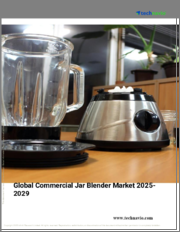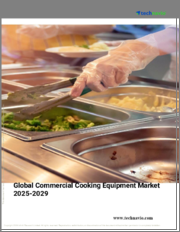
|
시장보고서
상품코드
1663904
상업용 조리 기기 시장 규모, 점유율, 성장 분석 : 제품 유형별, 최종 용도별, 지역별 - 산업 예측(2025-2032년)Commercial Cooking Equipment Market Size, Share, and Growth Analysis, By Product Type (Broilers, Cook-chill Systems), By End-Use (Full-Service Restaurant, Quick Service Restaurant), By Region - Industry Forecast 2025-2032 |
||||||
세계의 상업용 조리 기기 시장 규모는 2023년에 130억 4,000만 달러로 평가되며, 2024년 138억 달러에서 2032년에는 216억 6,000만 달러로 성장하며, 예측 기간(2025-2032년)의 CAGR은 5.8%로 성장할 전망입니다.
세계 상업용 조리기기 시장은 건강과 환경적 지속가능성에 대한 관심이 높아지면서 크게 성장하고 있습니다. 제조업체들은 엄격한 세계 규제를 준수하면서 배출가스와 에너지 소비를 최소화하는 친환경 가전제품의 개발에 박차를 가하고 있습니다. 혁신적인 기술에는 에너지 효율이 높은 기계와 지속가능한 재료가 포함되며, 이는 환경에 도움이 될 뿐만 아니라 기업의 운영 비용도 절감할 수 있습니다. 또한 에어프라이어, IH 쿠킹 히터 등 건강한 조리법을 장려하는 가전제품이 건강 지향적인 소비자들 사이에서 인기를 끌고 있습니다. 시장은 또한 중소규모의 외식 사업자를 위해 조정된 모듈식 소형 장비로 전환하고 있으며, 주방의 효율성을 극대화하고 있습니다. 스마트 조리 기술이 제어성과 효율성을 향상시킴에 따라 이 분야의 진화는 소비자의 선호도 변화를 반영하고 지속가능성을 중시하는 방향으로 발전하고 있으며, 이는 향후 강력한 성장을 예고하고 있습니다.
목차
서론
- 조사의 목적
- 조사 범위
- 정의
조사 방법
- 정보 조달
- 2차와 1차 데이터 방법
- 시장 규모 예측
- 시장의 전제조건과 제한
개요
- 세계 시장 전망
- 공급과 수요 동향 분석
- 부문별 기회 분석
시장 역학과 전망
- 시장 개요
- 시장 규모
- 시장 역학
- 촉진요인과 기회
- 억제요인과 과제
- Porter의 산업 분석
주요 시장 인사이트
- 주요 성공 요인
- 경쟁의 정도
- 주요 투자 기회
- 시장 에코시스템
- 시장의 매력 지수(2024년)
- PESTEL 분석
- 거시경제 지표
- 밸류체인 분석
- 가격 분석
상업용 조리 기기 시장 규모 : 제품 유형별
- 시장 개요
- 브로일러
- 쿡-칠 시스템
- 프라이어
- 오븐
- 쿠커
- 레인지
- 주전자
- 스티머
- 기타
상업용 조리 기기 시장 규모 : 최종 용도별
- 시장 개요
- 풀 서비스 레스토랑
- 퀵서비스 레스토랑
- 케이터링
- 호텔 & 레스토랑
- 병원
- 기타
- 페리와 크루즈
- 시설내 식당
상업용 조리 기기 시장 규모
- 북미
- 미국
- 캐나다
- 유럽
- 독일
- 스페인
- 프랑스
- 영국
- 이탈리아
- 기타 유럽 지역
- 아시아태평양
- 중국
- 인도
- 일본
- 한국
- 기타 아시아태평양
- 라틴아메리카
- 브라질
- 기타 라틴아메리카 지역
- 중동 및 아프리카
- GCC 국가
- 남아프리카공화국
- 기타 중동 및 아프리카
경쟁 정보
- 상위 5사의 비교
- 주요 기업의 시장 포지셔닝(2024년)
- 주요 시장 기업이 채택한 전략
- 최근 시장 동향
- 기업의 시장 점유율 분석(2024년)
- 주요 기업의 기업 개요
- 기업의 상세
- 제품 포트폴리오 분석
- 기업의 부문별 점유율 분석
- 매출의 전년대비 비교(2022-2024)
주요 기업 개요
- AB Electrolux(Sweden)
- Illinois Tool Works Inc.(United States)
- John Bean Technologies Corp.(United States)
- The Middleby Corporation(United States)
- Haier Group(China)
- Hoshizaki Corporation(Japan)
- Alto-Shaam, Inc.(United States)
- Marmon Foodservice Technologies(United States)
- Duke Manufacturing Company(United States)
- Rational AG(Germany)
- UNOX S.p.A.(Italy)
- GEA Group Aktiengesellschaft(Germany)
- Twothousand Machinery Co., Ltd.(China)
- Weber Inc.(United States)
- Selecta Group(Switzerland)
- Quench(United States)
- Restaurant Technologies(United States)
- Electrolux Professional AB(Sweden)
- BSH Hausgerate GmbH(Germany)
- Dover Corporation(United States)
결론과 제안
KSA 25.04.01Global Commercial Cooking Equipment Market size was valued at USD 13.04 billion in 2023 and is poised to grow from USD 13.8 billion in 2024 to USD 21.66 billion by 2032, growing at a CAGR of 5.8% during the forecast period (2025-2032).
The global commercial cooking equipment market is experiencing substantial growth, primarily fueled by rising health and environmental sustainability concerns. Manufacturers are increasingly developing eco-friendly appliances that minimize emissions and energy consumption while adhering to stringent global regulations. Innovations include energy-efficient machines and sustainable materials, which not only benefit the environment but also lower operational costs for businesses. Additionally, appliances that promote healthy cooking practices, such as air fryers and induction cooktops, are gaining traction among health-conscious consumers. The market is also shifting towards modular and compact equipment tailored for small and medium-sized foodservice businesses, maximizing kitchen efficiency. As smart cooking technology improves control and efficiency, the sector's evolution reflects shifting consumer preferences and emphasizes sustainability, suggesting robust future growth.
Top-down and bottom-up approaches were used to estimate and validate the size of the Global Commercial Cooking Equipment market and to estimate the size of various other dependent submarkets. The research methodology used to estimate the market size includes the following details: The key players in the market were identified through secondary research, and their market shares in the respective regions were determined through primary and secondary research. This entire procedure includes the study of the annual and financial reports of the top market players and extensive interviews for key insights from industry leaders such as CEOs, VPs, directors, and marketing executives. All percentage shares split, and breakdowns were determined using secondary sources and verified through Primary sources. All possible parameters that affect the markets covered in this research study have been accounted for, viewed in extensive detail, verified through primary research, and analyzed to get the final quantitative and qualitative data.
Global Commercial Cooking Equipment Market Segments Analysis
Global Commercial Cooking Equipment Market is segmented by Product Type, End-Use and region. Based on Product Type, the market is segmented into Broilers, Cook-chill Systems, Fryers, Ovens, Cookers, Ranges, Kettles, Steamers and Others. Based on End-Use, the market is segmented into Full-Service Restaurant, Quick Service Restaurant, Catering, Hotels & Restaurants, Hospitals and Others. Based on region, the market is segmented into North America, Europe, Asia Pacific, Latin America and Middle East & Africa.
Driver of the Global Commercial Cooking Equipment Market
The Global Commercial Cooking Equipment market is experiencing significant growth driven by the rising adoption of energy-efficient appliances in commercial kitchens. Establishments are increasingly investing in eco-friendly cooking solutions to lower operational costs and comply with environmental regulations as sustainability gains importance. Key contributors to this market expansion include the widespread use of energy-efficient fryers, ovens, and induction cooktops within the foodservice sector. Additionally, this movement aligns with the growing consumer demand for green practices, further propelling the shift towards more sustainable cooking options in the industry, ultimately enhancing business profitability while benefiting the environment.
Restraints in the Global Commercial Cooking Equipment Market
Despite the potential long-term advantages of industrial cooking equipment, the substantial upfront costs associated with high-tech, energy-efficient models can pose a significant barrier, particularly for startups and smaller businesses. The financial burden of acquiring such equipment may be beyond their reach, which can stifle market expansion. These monetary constraints can restrict their capability to invest in automated solutions, ultimately hindering their growth prospects. Consequently, the high initial investment required for advanced commercial cooking equipment serves as a notable restraint in the Global Commercial Cooking Equipment market, potentially impeding the adoption and progress of businesses operating on a limited budget.
Market Trends of the Global Commercial Cooking Equipment Market
The Global Commercial Cooking Equipment market is witnessing a significant shift towards smart cooking appliances, driven by advancements in IoT technology. These innovative appliances enhance operational efficiency and food quality through their networking capabilities, which enable energy conservation and ensure consistent cooking results. The ability for operators to remotely monitor and manage cooking processes is increasingly appealing to businesses aiming to streamline operations and reduce labor costs. This trend is propelling industry growth as manufacturers focus on developing intelligent and connected appliances, positioning smart technology as a key differentiator in the competitive commercial cooking landscape through 2023 and beyond.
Table of Contents
Introduction
- Objectives of the Study
- Scope of the Report
- Definitions
Research Methodology
- Information Procurement
- Secondary & Primary Data Methods
- Market Size Estimation
- Market Assumptions & Limitations
Executive Summary
- Global Market Outlook
- Supply & Demand Trend Analysis
- Segmental Opportunity Analysis
Market Dynamics & Outlook
- Market Overview
- Market Size
- Market Dynamics
- Drivers & Opportunities
- Restraints & Challenges
- Porters Analysis
- Competitive rivalry
- Threat of substitute
- Bargaining power of buyers
- Threat of new entrants
- Bargaining power of suppliers
Key Market Insights
- Key Success Factors
- Degree of Competition
- Top Investment Pockets
- Market Ecosystem
- Market Attractiveness Index, 2024
- PESTEL Analysis
- Macro-Economic Indicators
- Value Chain Analysis
- Pricing Analysis
Global Commercial Cooking Equipment Market Size by Product Type & CAGR (2025-2032)
- Market Overview
- Broilers
- Cook-chill Systems
- Fryers
- Ovens
- Cookers
- Ranges
- Kettles
- Steamers
- Others
Global Commercial Cooking Equipment Market Size by End-Use & CAGR (2025-2032)
- Market Overview
- Full-Service Restaurant
- Quick Service Restaurant
- Catering
- Hotels & Restaurants
- Hospitals
- Others
- Ferry & Cruise
- Institutional Canteens
Global Commercial Cooking Equipment Market Size & CAGR (2025-2032)
- North America (Product Type, End-Use)
- US
- Canada
- Europe (Product Type, End-Use)
- Germany
- Spain
- France
- UK
- Italy
- Rest of Europe
- Asia Pacific (Product Type, End-Use)
- China
- India
- Japan
- South Korea
- Rest of Asia-Pacific
- Latin America (Product Type, End-Use)
- Brazil
- Rest of Latin America
- Middle East & Africa (Product Type, End-Use)
- GCC Countries
- South Africa
- Rest of Middle East & Africa
Competitive Intelligence
- Top 5 Player Comparison
- Market Positioning of Key Players, 2024
- Strategies Adopted by Key Market Players
- Recent Developments in the Market
- Company Market Share Analysis, 2024
- Company Profiles of All Key Players
- Company Details
- Product Portfolio Analysis
- Company's Segmental Share Analysis
- Revenue Y-O-Y Comparison (2022-2024)
Key Company Profiles
- AB Electrolux (Sweden)
- Company Overview
- Business Segment Overview
- Financial Updates
- Key Developments
- Illinois Tool Works Inc. (United States)
- Company Overview
- Business Segment Overview
- Financial Updates
- Key Developments
- John Bean Technologies Corp. (United States)
- Company Overview
- Business Segment Overview
- Financial Updates
- Key Developments
- The Middleby Corporation (United States)
- Company Overview
- Business Segment Overview
- Financial Updates
- Key Developments
- Haier Group (China)
- Company Overview
- Business Segment Overview
- Financial Updates
- Key Developments
- Hoshizaki Corporation (Japan)
- Company Overview
- Business Segment Overview
- Financial Updates
- Key Developments
- Alto-Shaam, Inc. (United States)
- Company Overview
- Business Segment Overview
- Financial Updates
- Key Developments
- Marmon Foodservice Technologies (United States)
- Company Overview
- Business Segment Overview
- Financial Updates
- Key Developments
- Duke Manufacturing Company (United States)
- Company Overview
- Business Segment Overview
- Financial Updates
- Key Developments
- Rational AG (Germany)
- Company Overview
- Business Segment Overview
- Financial Updates
- Key Developments
- UNOX S.p.A. (Italy)
- Company Overview
- Business Segment Overview
- Financial Updates
- Key Developments
- GEA Group Aktiengesellschaft (Germany)
- Company Overview
- Business Segment Overview
- Financial Updates
- Key Developments
- Twothousand Machinery Co., Ltd. (China)
- Company Overview
- Business Segment Overview
- Financial Updates
- Key Developments
- Weber Inc. (United States)
- Company Overview
- Business Segment Overview
- Financial Updates
- Key Developments
- Selecta Group (Switzerland)
- Company Overview
- Business Segment Overview
- Financial Updates
- Key Developments
- Quench (United States)
- Company Overview
- Business Segment Overview
- Financial Updates
- Key Developments
- Restaurant Technologies (United States)
- Company Overview
- Business Segment Overview
- Financial Updates
- Key Developments
- Electrolux Professional AB (Sweden)
- Company Overview
- Business Segment Overview
- Financial Updates
- Key Developments
- BSH Hausgerate GmbH (Germany)
- Company Overview
- Business Segment Overview
- Financial Updates
- Key Developments
- Dover Corporation (United States)
- Company Overview
- Business Segment Overview
- Financial Updates
- Key Developments
















